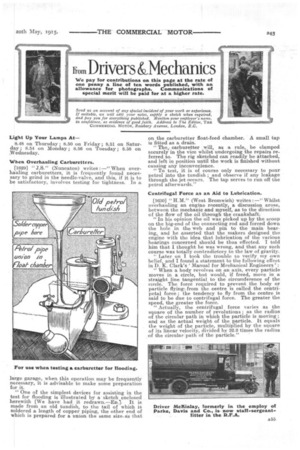from Drivers &Mechanics
Page 21

If you've noticed an error in this article please click here to report it so we can fix it.
We pay for contributions on this page at the rate of one penny a line of ten words published, with an allowance for photographs. Communications of special merit will be paid for at a higher rate.
Send us an account of any special incident of your work or experience, If suitable, we will edit your notes, supply a sketch when required, and pay you for everything published. Mention yozw emfiloyer's name, in confidence, as evidence of good faith. Address to The Editor, THE COMMERCIAL MOTOR, Rosebery Avenue, London, E.C,
Light Up Your Lamps At
8.48 on Thursday ; 8.50 on Friday; 8.51 on Saturday; 8.54 on Monia,y; 8.56 on Tuesday; 8.58 on Wednesday.
When Overhauling Carburetters.
[1629] " J.S." (Nuneaton) writes :—"When overhauling carburetters., it is frequently found necessa-ry to grind in the needle-valve, and this, if it is to be satisfactory, involves testing for tightness. In a
large garage, when this operation may be frequently necessary, it is advisable to make some preparation for it.
" One of the simplest devices for assisting in the test for flooding is illustrated by a sketch enclosed herewith [We have had it redrawn—En.]. It is made from an old tunclish, to the tail of which is soldered a length of copper piping, the other end of which is prepared for a union tho same size.as that
on the carburetter float-feed chamber, A small tap is fitted as a drain.
" Thei carburetter will, as a ride, be clamped securely in the vice whilst undergoing the repairs re-. ferred to. The rig sketched can readily be attached, and left in position until the work is finished without causing any inconvenience.
" To test, it is of course only necessary to pour petrol into the tundish; and observe if any leakage through the jet occurs. The tap serves to run off the petrol afterwards," Centrifugal Force as an Aid to Lubrication.
[1630] "H.M." (West Bromwich) writes :—" Whilst overhauling an engine recently, a discussion arose, between the mechanic and myself, as to the direction of the flow of the oil through the crankshaft.
"In his opinion the oil was picked up by the scoop on the big-end of the connecting rod and forced down the hole in the web and Din to the main bearing, and he asserted that the makers designed the engine, with the idea that. lubrication of the various bearings concerned should be thus effected. I told him that I thought he was wrong, and that any such course was totally contradictory to the law of gravity. " Later on I took the trouble to verify my own belief, and I found a statement to the following effect in D. K. Clark's 'Manual for Mechanical Engineers ' :
"When a body revolves on an axis, every particle moves in a circle, but would, if freed, move in a straight line tangential to the circumference of the circle. The force required to prevent the body or particle flying.. from the centre is called the centripetal force • the tendency to fly from the centre is said to be due to centrifugal force. The greater the speed, the greater the force.
" Actually, the centrifugal force varies as the square of the number of revolutions ; as the radius of the circular path in which the particle is moving ; and as the actual weight of the particle. It equals the weight of the particle, multiplied by the square of its linea-r velocity, divided by 32.2 times the radius
of the circular path of the particle."






















